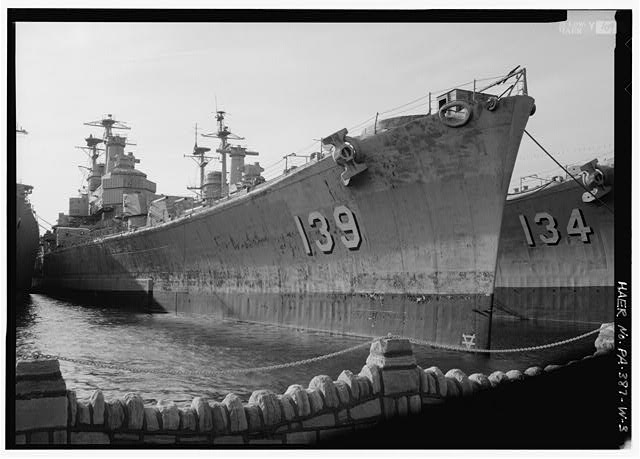
HAER
Philadelphia Naval Ship Yard, c. 1860
League Island, Philadelphia PA 19112
© John Mayer,
Workshop of the
World (Oliver Evans Press, 1990).
In
1801 the U.S. Navy purchased Joshua Humphrey's shipyard,
located near the foot of Washington Avenue on the
Delaware River. 1
Initially, the
Navy Yard only repaired vessels, but during the War of
1812 it began building ships. The first ship at the yard
was the USS Franklin, a 2,257 ton, 74 gun
ship-of-the-line, launched in 1815. Operations at this
original site greatly expanded during the Civil War, and
by war's end, the navy was eager to relocate to a new,
more commodious site.
The
Philadelphia Naval Shipyard on League Island was
established in 1871 on land purchased from the city
government. Since that time the, it has been an important
site for the repair and fabrication of naval
vessels. 2
The
yard has five drydocks for ship repair. Drydock No 1. was
built in 1891. The Spanish-American War created a need
for an additional drydock as well as new shop buildings.
During World War I, a third drydock, new ship ways and
the 350 ton, hammerhead crane were added to the site. By
April 1919, the yard employed 12,000 workers.
Typically, activities at the yard have increased in
response to wartime efforts. During World War II, nearly
47,000 people worked at the yard constructing various
types of ships, including the battleship Washington, the
aircraft carrier Antietam, destroyer escorts, and landing
ships. 3
The
yard covers 793 acres. At the west end of the yard are
the remnants of a seaplane factory and hangars dating
from World War I. 4
Today, the yard
manages a mothball fleet and is used for the refurbishing
of naval vessels, including aircraft carriers. It is the
only yard on the East Coast capable of manufacturing
propellers. More than 9,000 civilian workers are
presently employed at the yard.
1 See Teitelman, Plate 29
for c. 1800 view of Humphrey's shipbuilding yard.
2 Hugh Scott,
"Our
Navy Yard," The Philadelphia Inquirer
Magazine, (November 29, 1964), pp. 8-14. See also Federal
Writers Project, Philadelphia,
A Guide to the Nation's
Birthplace,
(Harrisburg, 1937) pp. 447-448.
3 Leslie A.
Kniskern, "History
of the Philadelphia Naval Shipyard,"
unpublished
paper, c. 1950. From the files of the Philadelphia
Naval Ship Yard.
4 Philip Scranton and
Walter Licht, Work
Sights, Industrial Philadelphia,
1850-1950, (Philadelphia, 1986), p.
230.
Update May
2007 (by
Joel Spivak, based on excerpts from 2004
Philadelphia Navy Yard Master Plan, Philadelphia
Industrial Development Corporation and the
Navy Yard website.)
The last station log for the Philadelphia Naval Shipyard
was entered on September 27, 1996, ending over 200 years
of the U.S. Navy’s operation of a military base in
Philadelphia.
Today, under the guidance of the Philadelphia Industrial
Development Corporation, the Philadelphia Navy Yard is
experiencing a renaissance as a master plan for
redevelopment by architect Robert A. M. Stern is being
carried out. The plan calls for a mixed-use waterfront
community that includes everything one would expect from
a great city: industrial development, offices, retail,
waterfront amenities, research and development, improved
mass transit, great public spaces, and the potential for
residential development. Indeed, it even includes a
private shipbuilding yard, Aker Philadelphia, a
reflection of Philadelphia’s role in the world
economy in the 21st century. In 2006 Aker delivered one
ship and four others were in construction.
Other enterprises at the Naval Yard include Penn State
University’s master’s program in Systems
Engineering, a data and operations center for the
Philadelphia Stock Exchange, and App Tec Laboratory
Services, a pharmaceutical lab and manufacturer. Urban
Outfitters moved its headquarters from Center City to a
former pipe-fitting complex. The company chose an unusual
renovation strategy, preserving much of the
industrial character and history of its five
buildings that together contain 280,000 square feet.
Surfaces were cleaned rather than sandblasted, so layers
of paint, grease stains and miscellaneous worker's
markings are retained. Future plans call for development
of a forty-acre industrial park and a 600,000 square foot
produce and seafood distribution center. On May 9, 2007
Tasty Baking Co. announced plans to build a 350,000 sq ft
highly automated bakery as big as six football fields.
The plant, to be completed in 2009, will be located in
the area known as Girard Point at the south end of the
Navy yard.
The 167-acre historic core of the naval yard is a
National Register Historic District with more than 2.5
acres of water front. The core offers opportunities for
renovation of existing buildings for commercial use, and
for the conversion of older loft space for residential
use.
See
also:
MS&R Architects preserves the industrial character of
five historic industrial buildings at the Navy Yard for
Urban Outfitters. Inga Saffron, "A Stitch in
Time," Metropolis Magazine, May
2007.
Historic American Engineering
Record - many records, search for
"Naval Base Philadelphia"